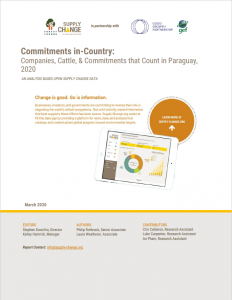Commitments in-Country: Companies, Cattle, & Commitments that Count in Paraguay
By Philip Rothrock, Laura Weatherer View PublicationOver the past few decades, Paraguay has had one of the highest rates of forest loss in the world, largely due to rapid expansion of cattle ranching, especially in the western Chaco region. Here, cattle are raised to produce beef, leather, and dairy products; most of the leather and beef is exported internationally to satisfy consumer demand around the world.
Many of the markets where Paraguay hopes to increase its cattle product exports have strict import requirements for traceability and health standards. These markets are also increasingly considering strengthening their environmental standards. At the same time, a growing number of influential companies that use cattle products are making commitments to eliminate or reduce deforestation in their cattle supply chains. Strengthening forest protections could be an economic growth opportunity for Paraguay and could position the country well to capitalize on the growing market for sustainably produced cattle products.
This report features:
- Discussion about land use change, environmental policy, and the cattle industry in Paraguay;
- Supply Change’s analysis of more than 80 companies believed to source cattle products from Paraguay and implications for corporate demand for sustainably reared cattle; and
- Case studies featuring key players in the Paraguay cattle industry and lessons learned from Brazil’s approach to improving sustainability in its cattle industry.
Press Release
- Full press release here [in English and Spanish].
Presentations
- Philip Rothrock at Latin American Sustainable Beef Vision Summit, July 10-12, 2019, in São Paulo, Brazil [slides]
- Philip Rothrock at Global Forest Watch Summit: Monitoring forests, mobilizing action, June 18-19, 2019, in Washington DC, USA [slides]
- Stephen Donofrio at Good Growth Conference, May 13-17, 2019, in Lima, Peru, and the Peruvian Amazon
Additional Resources
- International Finance Corporation in Paraguay
- Green Commodities Programme in Paraguay

